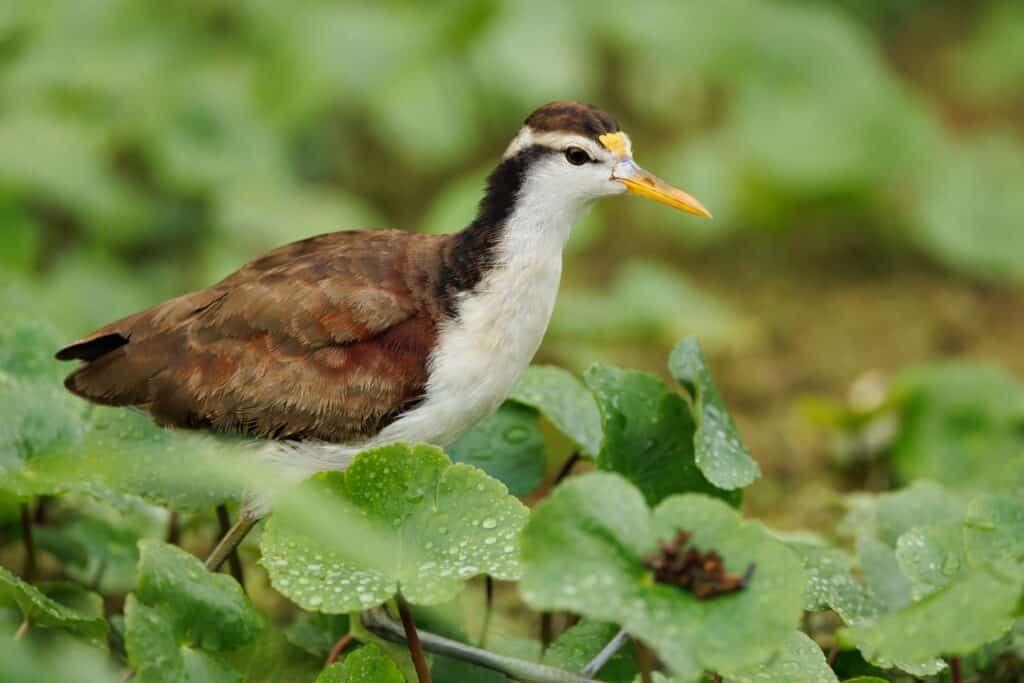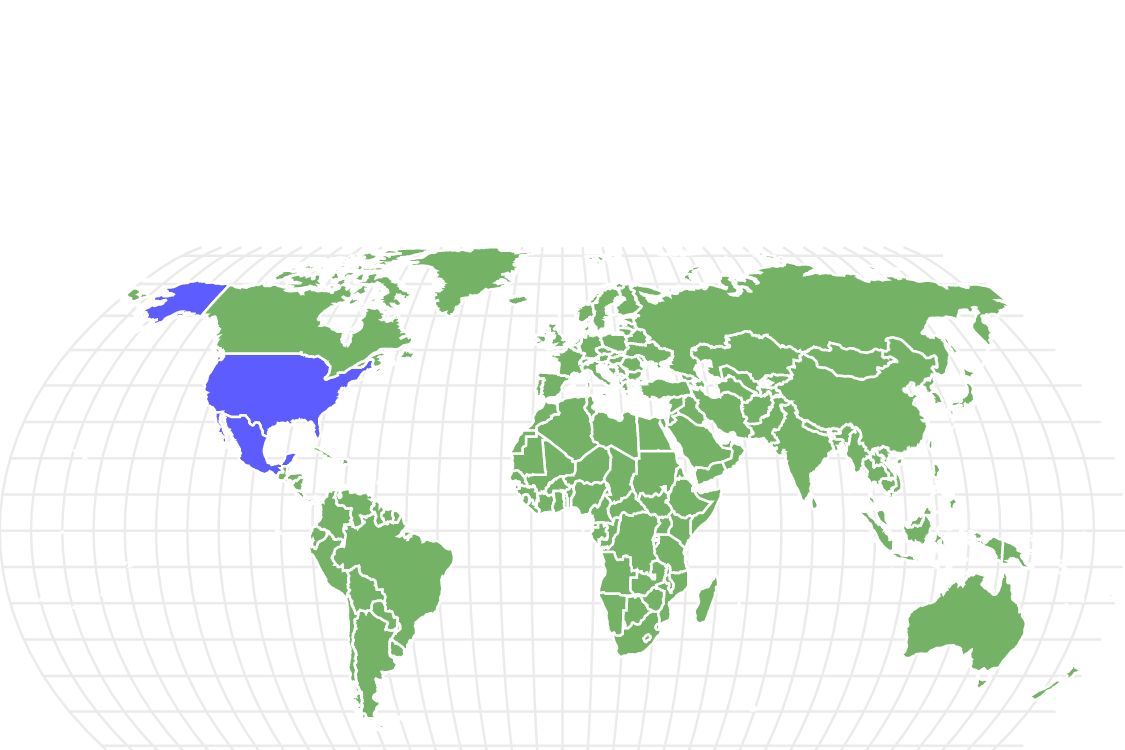Northern Jacana
Jacana Spinosa
The northern jacana is one of two species found in the Americas, from the United States to Panama.
Advertisement
Northern Jacana Scientific Classification
- Kingdom
- Animalia
- Phylum
- Chordata
- Class
- Aves
- Order
- Charadriiformes
- Family
- Jacanidae
- Genus
- Jacana
- Scientific Name
- Jacana Spinosa
Read our Complete Guide to Classification of Animals.
Northern Jacana Conservation Status
Northern Jacana Facts
- Prey
- insects, small fish, snails, worms, crabs, mollusks, and seeds
- Main Prey
- Aquatic insects
- Name Of Young
- Chicks
- Group Behavior
- Social
- Fun Fact
- The northern jacana is one of two species found in the Americas, from the United States to Panama.
- Estimated Population Size
- 500,000 to 5 million
- Biggest Threat
- Habitat loss
- Most Distinctive Feature
- yellow wattle on its forehead and the yellowish-green flight feathers
- Distinctive Feature
- dark brown bodies, yellow bills, and black necks
- Wingspan
- 20 inches
- Incubation Period
- 28 days
- Age Of Independence
- One year
- Age Of Fledgling
- 8 weeks
- Habitat
- coastal areas in marshes, swamps, ponds, and lake margins
- Predators
- boa constrictors, snapping turtles, birds of prey, and various mammals
- Diet
- Carnivore
- Lifestyle
- Diurnal
- Favorite Food
- Aquatic insects
- Type
- Bird
- Common Name
- Northern jacana
- Special Features
- Bony wing spurs
- Location
- North America
- Average Clutch Size
- 4
- Nesting Location
- floating aquatic vegetation
View all of the Northern Jacana images!
“Their huge feet and claws allow them to walk on floating vegetation.”
Summary
The northern jacana (Jacana Spinosa) is a medium-sized wader from North America, primarily in the tropics in Central America. It inhabits marshes and swamps near coastal areas, where it spends its days walking across floating vegetation and picking insects off aquatic plants. This species is relatively social and lives in small colonies, where the fathers raise their young, and the females spread their egg clutches around. Find out everything there is to know about this North American jacana, including its habitat, diet, and reproduction.
5 Amazing Northern Jacana Facts
- The northern jacana is one of two species found in the Americas, from the United States to Panama.
- This jacana species is distinguishable by the yellow wattle on its forehead and the yellowish-green flight feathers.
- These birds are relatively social and live in small colonies with a dominant female.
- They are nonmigratory but may occasionally wander north to the Southern United States.
- Males and females give alarm calls and charge at intruders.
Where to Find the Northern Jacana
The northern jacana lives in North America in 13 countries, including the United States, Mexico, Costa Rica, Cuba, and Jamaica. Their population is most concentrated from Mexico to Panama and only occasionally wanders to the Southern United States in Texas, Arizona, and Florida. You will often find this bird near coastal areas in marshes, swamps, ponds, and lake margins. Their habitats must contain floating plants like lily pads and water hyacinths. In the United States, you can spot them in shallow freshwater ponds.
Northern Jacana Nest
Males make loosely-constructed platforms on floating aquatic vegetation. Occasionally they add plants around the eggs as nesting material to help conceal them.
Scientific Name
The northern jacana (Jacana Spinosa) is from the Charadriiformes order, which contains 390 bird species that live near water and eat invertebrates. Its Jacanidae family encompasses the jacanas, a group of tropical waders. The genus, Jacana, comprises the American species, including the northern and wattled jacana.
Size, Appearance, & Behavior

Northern jacana emit “clustered note calls” with their young or mating pair. They will also make alarm calls when threatened.
©Jean-Baptiste Toussant/Shutterstock.com
The northern jacana is a medium-sized wader, measuring eight inches long and weighing between three and five ounces, with a 20-inch wingspan. They have a small yellow wattle on their foreheads and bony spurs on their wings to defend themselves from predators. Males and females have similar coloring, which includes dark brown bodies, yellow bills, and black necks and heads. Its primary and secondary feathers are yellowish-green and visible when in flight. They emit “clustered note calls” with their young or mating pair. They will also make alarm calls when threatened. This species is relatively social and occurs in small colonies with a dominant female. Like other jacanas, the northern species is a weak flier and prefers to wade in the water.
Migration Pattern and Timing
These birds do not regularly migrate, but they may occasionally stray to Texas, Arizona, and Florida after a season of good rainfall.
Diet
Northern jacanas are carnivores who primarily eat insects.
What Does the Northern Jacana Eat?
The northern jacana’s main prey is aquatic insects, but they also consume small fish, snails, worms, crabs, mollusks, and seeds. They forage by walking on floating vegetation and picking insects off plants or the water’s surface. You may also find them in the mud or open ground near water.
Predators, Threats, and Conservation Status
The IUCN lists the northern jacana as LC or “least concern.” Due to its extensive range and significant population size, this species does not meet the “threatened” status thresholds. While they are not experiencing any existential threats, they may be susceptible to losing their wetland habitats in the future.
What Eats the Northern Jacana?
Northern jacana predators include boa constrictors, snapping turtles, birds of prey, and various mammals. Purple gallinules, a crain-like rail species, are their most significant nest predator. These birds will steal eggs and young when the male jacana is away. To defend themselves and their young, northern jacanas spread their wings, give repeated alarm calls, and charge at intruders.
Reproduction, Young, and Molting
The breeding season varies throughout its range but usually coincides with the rainy season. Northern jacanas participate in a polyandrous mating system, in which the females copulate with several males to spread their egg clutches around, and the males are solely in charge of caring for the eggs and raising their young. Females lay four eggs, and males incubate them for approximately 28 days. While the young fledge the nest 24 hours after hatching, they are fiercely protected until they are around eight weeks old. They may stay under the protection of their father for up to one year. Jacanas can’t start their own territories until they are at least two years old. These birds have an average lifespan of 6.5 years.
Population
The global northern jacana population is estimated to be 500,000 to 5 million mature individuals. We don’t know their population trend, whether they are increasing or decreasing, because of the uncertainty over the impacts of habitat modification. However, there don’t appear to be any extreme fluctuations or fragmentations in their numbers.
Similar Animals:
View all 65 animals that start with NNorthern Jacana FAQs (Frequently Asked Questions)
Where do northern jacana live?
The northern jacana lives in North America in 13 countries, including the United States, Mexico, Costa Rica, Cuba, and Jamaica. Their population is most concentrated from Mexico to Panama.
How big is the northern jacana?
The northern jacana is a medium-sized wader, measuring eight inches long and weighing between three and five ounces, with a 20-inch wingspan.
What do northern jacanas sound like?
They emit “clustered note calls” with their young or mating pair. They will also make alarm calls when threatened.
Do northern jacana migrate?
These birds do not regularly migrate, but they may occasionally stray to Texas, Arizona, and Florida after a season of good rainfall.
What do northern jacanas eat?
The northern jacana’s main prey is aquatic insects, but they also consume small fish, snails, worms, crabs, mollusks, and seeds.
What threatens the northern jacana?
While they are not experiencing any existential threats, they may be susceptible to losing their wetland habitats in the future.
What preys on northern jacana?
Northern jacana predators include boa constrictors, snapping turtles, birds of prey, and various mammals. Purple gallinules, a crain-like rail species, are their most significant nest predator.
Thank you for reading! Have some feedback for us? Contact the AZ Animals editorial team.
Sources
- Red List / BirdLife International, Available here: https://www.iucnredlist.org/species/22693550/168911151
- JSTOR / The Wilson Bulletin Vol 103, Available here: https://www.jstor.org/stable/4163086

















